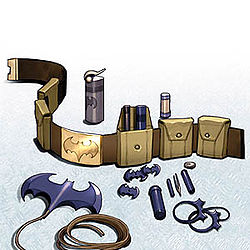Nature’s Batman Utility Belt: The Genome
A trilogy and controversial main-character bait-and-switch later, the Dark Knight has resurfaced as a new age hero, bent on brooding and fighting crime from the rooftops of Gotham City. However, one of the greatest mysteries in the story of this powerful vigilante is how his utility belt, which usually stands out bright yellow against his otherwise matte black body armor, always seems to have the right tools on hand for saving the world from someone that day.

Since I am not Batman, I cannot provide an answer to those questions, but it may be useful to think of another daily occurrence to serve as an analogy for B-man’s belt: genomics. Throughout my time participating in research, I have been fortunate enough to have mentors who always taught me techniques with an eye permanently fixed on the scientific future. Their guidance helped me gain insight into what I saw as nature’s utility belt: a series of codes (genomic DNA), complete with a printer (RNA synthase), that allowed any cell to print out the exact instructions it needed (messenger RNA) for the tools (proteins) exactly when they were needed. In that sense, nature and Batman are not all that different.

However, genomics and genetic expression do have some quirks of its own. One reoccurring theme in nature is the reappearance of the same gene during development in completely different organs! One of the most notable is the prevalence of messenger RNA sequences coding for a class of proteins known as claudins. Claudins act like the nails in a wall, sticking the membranes of adjacent cells together to form a water-tight junction between them.
During development, we can locate where these specific mRNA sequences are expressed by a process known as whole mount in situ hybridization, abbreviated WISH. By exposing whole zebrafish embryos to sequences of RNA directly opposite the normal sequence found in the embryos, these two sequences stick together within a cell in a process known as hybridization, where two separate sequences become one joint sequence. A protein carrying a dye can then attach to these pieces of hybridized RNA, which will deposit the dye in the cell upon exposure to a particular mixture of chemicals. Using this process, we can see that in early stages of zebrafish development, the sequences coding for members of the claudin family are expressed in many areas of the developing brain and surprisingly in the developing kidney as well!
Who would have thought that the organs used to produce thoughts, feelings, and memories would share structural similarities with an organ used for less glorious purposes on a molecular scale? Our genome is filled with such examples of multipurpose tools, expressed in organs that perform completely different functions. From junction proteins used to hold organs together to sodium channels (also coincidentally conserved between the brain and the kidneys), these structures, derived from the codes which unite all of us, form a powerful example about how intricately connected the structures of our bodies are.
However, this is where we must diverge from Batman. His utility belt may be all-purpose for him, but Mother Nature takes that concept a step further. This code, this natural utility belt, is replicated with striking similarity across all living organisms! They all function with a similar premise: From DNA to RNA to protein; manual to instruction to tool. However, every student with any fleeting interest in modern biology has known this fact, so I will attempt to illustrate the impact of this knowledge in a more concrete way.
Imagine, if you will, a world in which all living systems had a different form of molecular tool creation. In such a world, it would be likely that we would not nearly have the miracle cures of today, such as insulin for those afflicted with diabetes. The great strides or progress made through the use of animal models would never have happened. Almost all of modern progress in the biological sciences would never have been justified with medical relevance as an underpinning factor if this toolkit were not conserved between living species.
The remarkable functionality of the cells which constitute all living beings, and the degree to which they share commonalities, in and among organisms, is an amazing fact that breathed life into all fields of the biological sciences today. The ability to only synthesize the necessary components to our survival from second to second makes our cells extremely energy-efficient, and it also makes our genetic toolkit even more versatile than those dreamed up by the brains they initially created. On the off chance that you may be feeling a little less than super, it may be comforting to remember that at any given moment, every living cell in your body is performing feats beyond the capabilities of the richest superhero ever created.
[…] A trilogy and controversial main-character bait-and-switch later, the Dark Knight has resurfaced as a new age hero, bent on brooding and fighting crime fro […]